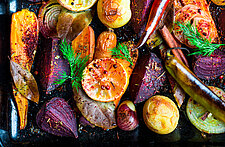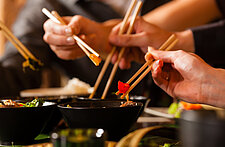Today we are kicking off Hispanic Heritage Month (9/15 - 10/15) on in-sight. Our first feature is an interview with the master of contemporary Mexican Cuisine, Chef Roberto Santibañez.
Recently, Symrise NA VP of Marketing, Emmanuel Laroche spoke with Roberto to get his take on everything from how his heritage influences his cuisine to which types of ingredients he prefers. The following is part one of a three part interview with Chef Roberto.
For Chef Roberto its all about flavor, the chili pepper, and the right amount of spicy.
Chef Roberto Santibañez is the chef and owner of two New York restaurants: La Botaneria in Park Slope, Brooklyn; and Fonda Manhattan. The teacher, author and award winning chef was raised in Mexico City and trained in Paris at the renowned Le Cordon Bleu culinary school. He went on to serve as Executive Chef at Fonda San Miguel in Austin, Texas, and was named “Best Chef” by the Austin Chronicle while also earning Five Stars from the Austin American Statesman. Zagat has cited expertise as living up to the “gold standard for upscale Mexican dining.”
How does your heritage influence your cuisine?
I was born and raised in Mexico City and grew up in a family of great cooks. I never wanted to do anything else but cook and I was sent to culinary school when I finished college. I went to France and studied at Le Cordon Bleu and then lived in Paris for a little while and went on to England, but always I missed my flavors and I went back to Mexico and that’s all I did, focus on those flavors. I started researching and
learning more and traveled around and made the right contacts with the right people like food writers and then I was on my way.
What type of ingredients or recipes from Mexico City influenced your cuisine?
Well, as you know Mexico uses a lot of chilies and most of our cuisine is based on chilies. That doesn’t necessarily mean that everything is spicy. We have some chilies that are very mild and we use them. Like the moles are made with different chilies, not the soggy varieties but those that are dry and very mild not fiery or spicy. My favorite thing is finding out how different chilies work with different things so it is a constant discovery to work with the varieties of chilies in different sauces and recipes.
Can you give us an example of mild chilies?
The more common ones are chilies anchos, chilies mulatos, chilies pasillas, chilies guajillos. These are the chilies that produce sauces so you can create plenty of them without being spicy. Sometimes they are so mild that you need to add a little heat to them and you go to other chilies such as chilies chipotles. There are at least three varieties of mild chilies that you can even get in markets in the United States. We really have hundreds of these, and that’s the fascinating thing – this vast universe means that you can use different chilies for different types and constantly create new recipes with them.
I understand that chipotles are the dry and smoky form of jalapeño. You referenced three, can you identify them?
The three varieties depends on the harvests, the first, the second and the third harvest – these all produce different chilies with different levels of flavors and different skin – they mature in different ways. There is chipotle meco, the larger, beige colored chili will create a completely different flavor in the sauce and the chipotle known as mora, the wrinkled red version – they both come from the same family but it depends on different ways of harvesting and smoking them. Terroir also has an effect in terms of rain, sunshine and soil.
Can you explain why people, other than Mexicans are frustrated because they find a different level of hotness and spiciness in the chilies used at different times?
Yes, that’s the challenge of our cuisine and it’s a headache for everybody. You know, things happen in processing plants. For instance, you may buy a thousand pounds of jalapeño and find 500 are not spicy and the other 500 are really spicy – so then your variation is huge. It depends on elements of the harvest – what time of the harvesting and the year, how much rain there has been, how dry it was, which plants are exposed to the sun more than others. It’s just a mess!
And this goes for all chilies?
For every single one of them. That’s why people go crazy when they go to Mexico. Even if they are the same kind, if the chilies are picked at different times, dried differently, they are not the same. The taste is never the same. The whole country is filled with different chilies.
So, the challenge of using chilies is similar to that of making wine and the effects of the elements like rain, sunshine, etc.?
Yes, you can actually recognize jalapenos that were harvested in California – they certainly don’t taste like the ones we grow and use in Mexico.
Check back next week on in-sight for part 2 of Emmanuel's interview with Chef Santibañez
Click here to see why you should subscribe to our weekly newsletter!




